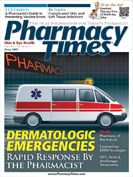Publication
Article
Pharmacy Times
Danger Lurks with Used Transdermal Patches
Author(s):
This convenient delivery system can sometimes cause accidental exposure to dangerous medications for children and pets.

This convenient delivery system can sometimes cause accidental exposure to dangerous medications for children and pets.
Parents, grandparents, and anyone wearing or disposing of a transdermal patch that contains any medication need to be extra cautious when there are children and pets in the household. All too often the Institute for Safe Medication Practices (ISMP) learns about tragedies where children have been exposed to transdermal patches that fell off a family member or that were discarded after use and found in a trash can.
Accidental Exposure
Recently, a physician alerted ISMP to an incident that nearly caused the death of an 8-month-old boy. At home, the child found a lost 50 mcg/hour fentanyl transdermal system patch and placed it in his mouth, where it became affixed to his palate. Later, a grandparent, who was not aware that the baby had tried to ingest the used fentanyl patch, thought the baby looked sleepy and placed him in his crib for a nap. After a period of time, the grandparent heard “gurgling” sounds coming from the child’s crib. The child was flaccid and cyanotic.
Cardiopulmonary resuscitation was administered, 911 was called, and the child was transported to the emergency department (ED) for treatment, where the patch was noticed and removed from his mouth. The reversal agent naloxone was administered in the ED and the baby’s respirations rebounded within minutes. Fortunately, the child awakened and became more alert, although a second dose of naloxone was required 30 minutes later. The child was admitted to the intensive care unit for further treatment and observation because while he was unconscious he had aspirated, causing aspiration pneumonia. The child was treated with antibiotics and, thankfully, recovered without permanent harm.
In another report, a mother told ISMP that her 4-year-old child either retrieved a discarded patch from the trash, or opened a wrapper from a box of stored patches, and applied one to his body. His heartbroken mother found him dead on the floor of a bedroom near an overturned trash can. Other cases involved a child who was accidentally exposed to a patch that fell off a family member and another who removed a patch while his grandmother was sleeping and applied it to himself. Fortunately, in those cases, the children were not seriously injured.
Safe Practice Recommendations
It is critical that prescribers and pharmacists educate patients and caregivers regarding how to safeguard the use of transdermal patches at home. Provide the following suggestions to patients and caregivers to better protect children and pets.
Store transdermal patches safely. Keep new patches far out of the reach and sight of children. Children may mistake transdermal patches for Band-Aids or temporary tattoos. A high cabinet secured with a child-resistant cabinet lock would be best. Avoid taking medication in front of children. Young children learn by imitating adults.
Dispose of patches safely. The fentanyl transdermal patch is one of a few medications that the FDA states should be flushed down the toilet for disposal to prevent danger to people and pets in the home. For other used transdermal patches, fold the sticky sides together and place them in a sturdy container, preferably with a child-resistant cap. Be sure the opening is big enough for a folded patch to go in but small enough that a child’s hand cannot. The container should be removed from the home frequently. Have current information on the proper disposal of patches to share with patients.
Keep track of patches on the body. Advise patients to keep track of where the patch has been affixed. Patients should check for the patch soon after they awaken, after a shower, anytime clothes are changed, and regularly during the day to make sure it has not fallen off or adhered to clothing.
Dr. Gaunt is a medication safety analyst and the editor of ISMP Medication Safety Alert! Community/ Ambulatory Care Edition.







